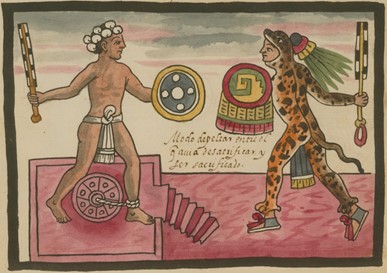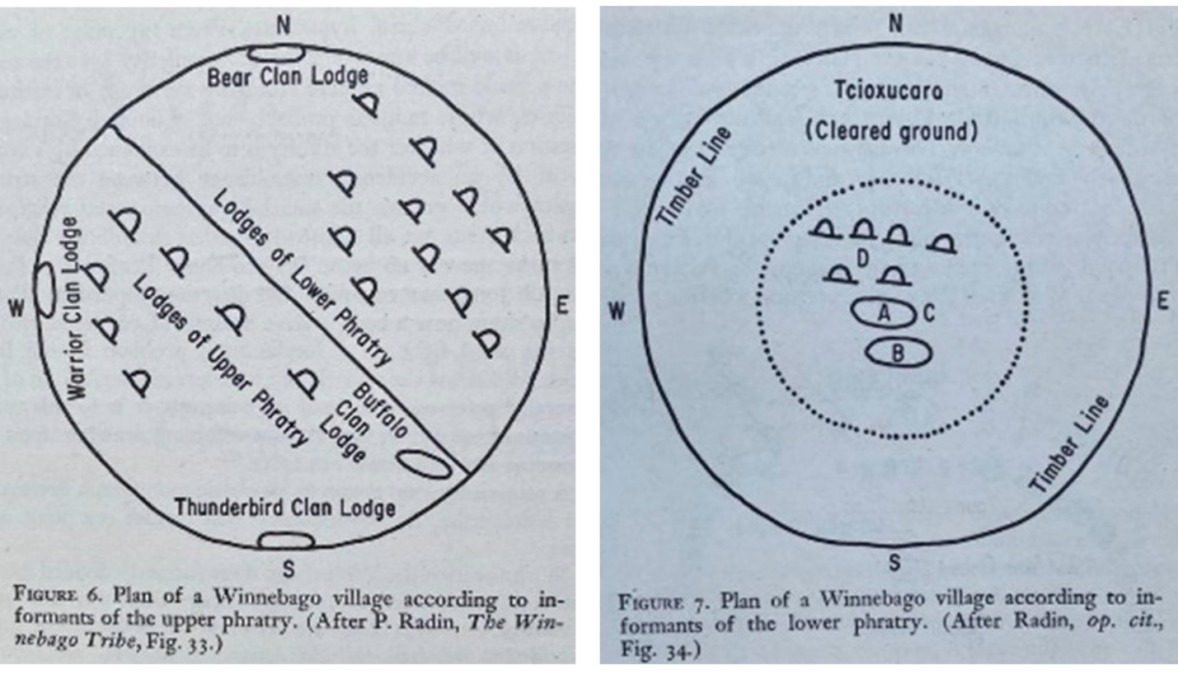
Editor’s Note: This is part II of “Social Dualism and the Problem of Archaic Inequality.”If you have not yet read part I, find it here.
Undoubtedly, some individuals who inhabit the marginal regions between two national coalitions can learn to jump between their points of view. Most of us, however, remain isolated, as if on an island or at an oasis in the middle of our culture. We’re only able to see our rivals as remote and monstrous creatures. Furthermore, a mental illusion held by millions of comrades has more power over our psyches than, say, a visual illusion. And what if it’s dangerous to tinker with the symbols and rites of rival groups? What if we’re in a fragile phase of collective development? We might destroy ourselves. We might more easily succumb to an external threat.
Claude Lévi-Strauss’s collection of essays, Structural Anthropology (1963), includes a reflection on bands of people drifting across a highland plateau in Brazil. With no more than a few dozen members, the bands were vulnerable to conquest and annihilation by disease and famine. Under such conditions, stories told by shamans, witches, and chieftains are likelier to go unchallenged. Just how somebody disappears and then reappears days later in a disheveled state might require a god of lightning or a magical flight through the air.
This is because such fictions are easier to swallow than the thought of unseemly sidebars with neighboring shamans, witches, or chieftains. Thus, some of our most cherished myths echo efforts to allow diplomacy among bands to occur anonymously and out of view. We probably use such stories to hide our diplomatic efforts even from ourselves. Otherwise, we might have to react to those efforts. But in a weakened social state, punishing treason is not just difficult; it’s costly. Disagreement might dissolve our band. Then, each of us is on our own, and our odds of survival go way down when we’re castaways or exiles.
A decade after Lévi-Strauss’s book, sociologist René Girard speculated in Violence and the Sacred (1972) that most archaic human communities took the form of these roaming bands, and most succumbed to natural forces, raids by other bands, or internal strife. They, therefore, left no fossil or archeological record. Lévi-Strauss and Girard imagine vast geographical and temporal reservoirs of small human subgroups. Only a tiny minority of these survive.
Our gloomy French theorists are in good company. Early in The Peloponnesian War—fifth century BC—Thucydides describes archaic Greece as a combative wasteland: “long ago what is now called ‘Hellas’ had no stable settlements; instead, there were various migrations in these early times and each group readily abandoned their own territory whenever forced to do so by those with superior numbers.”
In biological terms, Thucydides, Lévi-Strauss, and Girard imply population bottlenecks. Only limited assemblies of genes survived the long list of crises punctuating our species’ history.

Codex Tovar, “depicts a scene of gladiatorial sacrificial rite, celebrated on the festival of Tlacaxipehualiztli” — Wikimedia Commons
Attractive by default, then, are human groups that make it past the bottlenecks. By definition, they are us.
Thucydides, for example, was interested in a distinct, more climactic binary that affected “most of mankind” and arose long after the wandering bands: “Both sides came into the war at the height of their powers and in a full state of military readiness.” He further observed that “the rest of the Greek world had either taken sides right at the start or was now planning to do so” (PW 1.1). Thucydides is brilliant but suffers from a familiar bias: “I judge that earlier events were not on the same scale, either as regards their wars or in other respects” (PW 1.1). Unsurprisingly, all cultures assume we’re a cosmic dualism that emerged from some primordial violent muck. In the Quiché-Maya epic Popol Vuh, for instance, mud people, wood people, and monkeys precede the advent of human beings, who finally inherit the world from a pair of twin sky gods who become the sun and the moon.
The binaries in the Popol Vuh, Star Trek, or Romeo and Juliet are universal but never simple.
Elsewhere in Structural Anthropology, Lévi-Strauss looks at the Winnebago tribe of the Great Lakes region of North America. In 1915–16, Paul Radin interviewed the tribe’s upper and lower phratries. They reported different mental maps of their shared village. Something both tragic and comical haunts these tiny circular atlases. The upper phratry’s map shows twenty-two structures; the lower phratry’s contains eight. The upper phratry locates the lodges of the Warrior, Buffalo, Thunderbird, and Bear clans and divides the village in half; the lower phratry shows some mildly annotated structures and signals an external arc of land labeled “tcioxucara”—cleared ground. This vacant area between the village and the timberline only interests the lower phratry.

Radin, “Upper and Lower Phratry Plans of a Winnebago Village”
Radin regretted being unable to determine which was the true village layout. A half century later, though, Lévi-Strauss ventured a radical hypothesis:
These forms, as described, do not necessarily relate to two different organizations. They may also correspond to two different ways of describing one organization too complex to be formalized by means of a single model, so that the members of each moiety would tend to conceptualize it one way rather than the other, depending upon their position in the social structure. For even in such an apparently symmetrical type of social structure as dual organization, the relationship between moieties is never as static, or as fully reciprocal, as one might tend to imagine.
Competing diametric and concentric maps were found by Lévi-Strauss among archaic people also in Indochina, Malaysia, Java, Indonesia, Papua New Guinea, and North and South America. Tribes in Indochina and Malaysia, too, drew attention to timber lines and rings of cleared ground. An uncomfortable natural law animates these structures. When humans settle into moieties, we oppose disjointed ways of looking at a world we inhabit together. Haidt says our moieties express competing sets of ethical virtues. Perhaps. The Winnebago rendered their teams in a potentially ethical or normative way—“us versus them” (the “upper” view). But they also saw themselves in ontological terms—“us versus nature” (the “lower” view). And, in the final analysis, both views are spatial—diametric (“upper”) versus concentric (“lower”).
Lévi-Strauss was uncomfortable with his findings. He noted that archaic humans grasp that the diametric and concentric aspects of their respective moieties are unequal. Tribes always deploy antithetical terms to describe themselves: “superior and inferior, elder and younger, noble and common, strong and weak.” One school of sociopolitical theorists, whom we might call the “asymmetrical realists,” argues that these dyads indicate the existence of a “minority principle.” By making room for a minority, we avoid collapsing our natural social dualism into a potentially tyrannical monad. By contrast, Lévi-Strauss fretted about a lost archaic harmony: “How can moieties involved in reciprocal obligations and exercising symmetrical rights be at the same time hierarchically related?”[1]
It is, however, naïve to imagine that social symmetry is ever viable other than during brief singularities. Moreover, reciprocity is never perfect. This is merely to say that hierarchy and inequality are unavoidable and functional. Sometimes, we all know who should be in charge. But Lévi-Strauss turns away from asymmetrical realism by arguing that social dualism is a surface illusion that hides countless layers of contrasts. He forces us back to symmetry by deceptively leaping forward in the history of human development. He converts archaic tribes into pluralistic Western societies. In truth, even Western societies turn archaic and binary in a crisis.
Moreover, the different maps of the Winnebago village recorded by Radin show that symmetry is always already out of reach. By definition, political power skews our worldviews. Thus, the upper phratry thinks of life as a kind of football game in which two teams face off on a diagonal that slices across the middle of the field; the lower phratry experiences life as a motely band huddled together in fear of an external threat. We identify with the notion of one team against another, or else we imagine ourselves as a collective bullfighter in the middle of nature’s ring.
Many think football reflects a more civilized showdown, akin to a two-party system or a friendly contest between rival cities. Bullfighting rattles us. It echoes a more gruesome phase of development when we needed unity against a dangerous perimeter. But we ought to realize two things: (1) depending on our situation, “football mode” or “bullfight mode” are both useful; (2) each style can morph into the other. A corollary is that international relations are variations in relations between domestic moieties. Some nations tend to think we’re all playing football; others will sense only a bullfight.
Tocqueville saw a nation as two nations fighting over what it means to be one.
Most nations have international rivals; we face off against a foreign nation, which is also split domestically. A fan of Jefferson’s vision of imperial democracy, Tocqueville grasped the shock-absorbing benefits of polycentric arrangements. These can be mildly asymmetrical, as in Madisonian federalism, or they can be convoluted sets of kingdoms, counties, city-states, and viceroyalties coordinated under European monarchs. Either scenario is preferable to divisions artificially designed to enforce equality. After the carnage of the Napoleonic Wars (1803–15), Tocqueville was wary of the precision of dialectics and positivistic political maps (see DA 2.3.18–26).
But even the most realistic national structure is still useless on occasion.
Do we go with two parties and primaries or a multiparty parliamentary system? No ideal applies to all cultures. European social structures are for Europeans; American structures are for Americans. When dualism arises, it won’t matter. It’s more important for politics to address two questions: (A) Which power is waxing or waning? (B) Which political movement liberates or oppresses individuals? Furthermore, some must be prepared to move in either direction to allow positive change. Local government can promote freedom, but not always. Sometimes, centralized power dissolves a local tyranny. For example, certain regions might need better referees (judges) or new rules (constitutions). The Federalist Papers allowed that the national government and the Supreme Court should, at times, override the decisions of state legislatures and state courts. Since dualism is inevitable, facilitating mechanisms that promote centralization and subsidiarity makes sense going forward.
So much for trying to manage social dualism. What does it signal? Ultimately, it might offer us no more than crude measures of a given nation’s stability and direction. Some archeologists and historians claim, for instance, that the rise of the Aztec Empire reduced the number of sacrificial ballcourts in Central Mexico. How should we interpret this? Did the Aztecs repress a rival religion? Or did they merely reconfigure it? Maybe one type of religious contest was transformed into another, which then dovetailed more effectively with the dynamics of the new social order. Empires appear when people want a meaning in life that they’ve lost locally. Imperial warfare simplifies and scales a new domestic rite by aiming it at the expanding frontier.
Finally, changes in rites can be either reactions or causes.
One moiety might advocate for more bullfights precisely because the football model is flagging. A citizen hoping to salvage individual rights within the current social order might defend bullfights because she fears team sports will tear us apart and return us to a state of nature. Another might prefer football because she knows that individualism requires competitive governance, which keeps absolutism at bay.
Even if such questions boil down to individual tastes, this doesn’t mean we can avoid big choices. Our opinions underwrite our moieties. American novelist Ernest Hemingway loved bullfights; Jesuit historian Juan de Mariana despised them. Authors Juan de Timoneda and Miguel de Cervantes were intrigued by some primitive form of football. I suspect that once a culture has both modes, it’s best to let subsets of people attend to each of them. It’s hard to envision now, but someday, a bullfighter might need a football team, or a football team might need bullfighters.
[1] Compare Madison, Federalist 51; Kelsen, “The Minority Principle”; Schmitt, “State Ethics and the Pluralist State.”
Image by Ai Studio — Adobe Stock — Asset ID#: 812453710